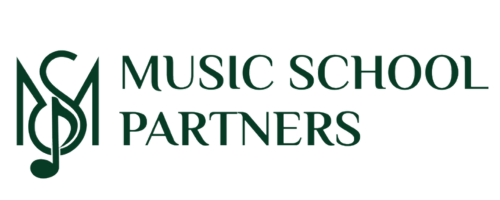Necessary mention: This guide is for educational purposes only and should not be considered financial, legal, or accounting advice. Music School Partners is not a certified financial advisor or CPA. We recommend consulting with a qualified professional before making any business, financial, or investment decisions.
Ok, let’s go!
Let’s be honest—most music school owners didn’t get into this to debate EBITDA at parties. But if you’ve ever peeked at your financial reports and thought, “What does that even mean?”—you’re not alone.
We’re breaking down some common business finance terms and what they actually mean in the real world of music education, so you can make smarter decisions without needing a finance degree.
Making Sense of the Money
We’ve all been there—wondering if that new student enrollment was enough to cover the extra marketing push this month, or squinting at QuickBooks wondering why the numbers don’t feel quite right even if the screen says “green.”
Running a music school isn’t just about teaching scales and harmonies—it’s also about keeping your business financially in tune. And let’s be real: most musicians don’t love spreadsheets. But understanding the financial side of your school is what helps keep the doors open, the teachers supported, and the students growing.
So let’s break down what really matters when it comes to business finances in a way that’s easy to follow—and maybe even a little bit empowering.
Know What’s Coming In and What’s Going Out
At its core, business finance is about two things: income and expenses. But it’s not just about tracking them—it’s about understanding them.
Let’s get into some terms you might see pop up on financial reports:
- Gross Revenue: The total amount your school earns before any bills are paid.
- Operating Expenses (OpEx): The everyday costs—like rent, payroll, utilities, and supplies—that keep your school running.
- Net Profit: What’s left over once the bills are paid. That’s the real “take-home” number you should care about.
- EBITDA: A bit of a mouthful (Earnings Before Interest, Taxes, Depreciation, and Amortization), but it shows how profitable your core music school operations are—without all the outside financial factors muddying the picture.
Why this matters: If you’re making $250,000 in gross revenue, but your net profit is only $5,000, it’s time to dig deeper. Tools like EBITDA help you spot whether the issue is with day-to-day operations or external costs like loan payments or equipment write-downs.
Tip: Set a 30-minute finance check-in once a month. Even a basic look at your income and expenses can reveal patterns you didn’t realize were there.
Pricing Isn’t Just a Number—It’s a Statement
Many music school owners struggle with pricing. How much can you charge? How much should you charge?
But here’s the thing: your price reflects not just your lessons, but the quality, care, and community your school offers. It also helps ensure you can pay your teachers fairly and keep your business running sustainably.
Understanding your break-even point—the number of students or dollars you need to bring in just to cover your costs—can give you clarity and confidence in your pricing.
If your monthly expenses are $15,000, and each student brings in $150/month, you need at least 100 active students to break even. Everything beyond that goes toward growth, reinvestment, and yes—your own paycheck.
Profit Isn’t a Bad Word
Your music school needs to make a profit.
Profit means you can invest in better equipment, hire amazing teachers, and maybe even take a vacation (remember those?). It’s not about greed—it’s about creating a buffer so you can support your students and yourself, even when the unexpected happens.
You cannot support your students and parents if each month you worry about making payroll. You cannot hire and retain the best teaching talent if you worry about making payroll. You cannot be in a mentally sound place – long term – if you worry about making payroll.
That is the theme here. I liked this short piece on how to raise teaching rates with grace. Dave includes these six ideas to consider when crafting that delicate notification to parents:
- Establish value
- Empathy
- State increase
- Why
- Added benefit
- Gratitude
And remember—terms like net profit and cash flow aren’t just for accountants. They’re there to help you make decisions, like whether now’s the time to bring on another teacher or expand into a second location.
Tools Can Help—But Only If You Use Them Right
There are plenty of financial tools out there, from bookkeeping software, to school-specific class management tools that track billing and payroll. But don’t get caught in the trap of tech for tech’s sake.
Start simple:
- Use a spreadsheet to track monthly income/expenses.
- Consider outsourcing bookkeeping if the DIY approach is holding you back.
Planning = Freedom
It’s easy to fall into reactive mode—fixing things as they break. But a little forward planning can go a long way.
Set goals like:
- Building a 3-month emergency fund
- Saving for a new studio upgraded website
- Creating a teacher bonus structure tied to enrollment growth
- Building a referral program
When you understand your break-even point, your cash flow cycle, and your monthly OpEx, you can plan with confidence—not guesswork.
Having your finances in order can also help if you ever choose to sell your music school.
It’s not about perfection—it’s about clarity. Even a basic budget can help you feel more in control and less stressed about what’s coming next.
Final Thought
You’re not expected to be an accountant and an educator and a marketer and a counselor all at once (though some weeks it might feel like you are).
However, you do need to understand your numbers to keep the doors open!
Meet Ray
Ray has managed millions in music school marketing budgets for a range of performing arts schools across the entire United States. His passion is helping school owners find their true value proposition and generate visibility in their communities.


